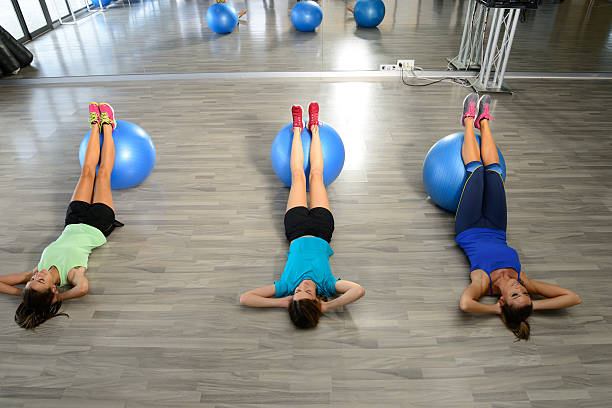DIFFERENT WAYS TO PERFORM SOME COMMON EXERCISES AT THE GYM

Deadlifts, bench presses, and squats are some of the most common exercises done in a gym. To avoid injury, you should monitor your form and ensure that all variations of these exercises are performed with the correct form. Begin with a lighter body weight or weight and increase the weight as you get more comfortable.
DEADLIFTS is a compound exercise that works for multiple muscle groups in the lower body, primarily the glutes (lower leg), hamstrings (upper leg), quads (lower leg), and core. This exercise can be performed in a variety of ways, including:
- Conventional deadlifts
The deadlift is performed in this way because it’s the most traditional and common. Start with the Barbell lying on the ground in front of you. Bend your knees, send your hips forward, and grab the bar using an overhand grip. Drive your heels through, engage your glutes, and then bring the bar up to its starting position.
- Sumo deadlifts
This variation involves standing with your feet facing outwards. The Barbell is now placed between your legs, and you grip the bar using an overhand hold. Push your legs outwards, lift the Barbell, and drive your heels. This variation focuses on the quadriceps, inner thighs, and inner thighs.
- Romanian deadlifts
This variation is a great way to target the glutes and hamstrings. Hold the Barbell in an overhand grasp, with your hands facing your thighs. Keep your back straight, hinge at your hips, and lower the weight until you feel your hamstrings being stretched. As soon as you feel the stretch in your hamstrings, squeeze your glutes. Straighten your hips out and return to your starting position.
- Deadlifts with stiff-legged legs
It is similar to the Romanian deadlift, but instead of bending them, you keep them straight through the entire movement. Keep your feet hip-width apart, and place the Barbell directly in front of your thighs. You can lower the Barbell by bending your knees or rounding your spine, but you should not bend your back. Then, lift it back up with your glutes.
- Trap bar deadlifts
This variation uses a specific trap bar that allows you to lift weights with a neutral rather than an overhand grip. You can lift heavier weights with this technique, and less strain is put on your lower back. Position yourself at the trap bar and grip the handles. Lift the weights by driving your heels.
Squats are one of the most effective exercises for building lower body strength. This exercise can be performed in a variety of ways, including:
- Bodyweight squats
This is the most basic and common form of squatting, making it ideal for beginners. Standing with feet slightly apart, toes pointing outwards, and shoulder-width apart is the best way to squat. By pushing your hips forward and bending your knees, you can squat. Make sure to keep your chest high and your weight on your heels. Push your heels up and go as low as possible before returning to your starting position.
- Goblet squats
With both hands, hold a dumbbell (or kettlebell) in front of you. Standing with feet slightly wider than shoulder width and toes facing outwards, place your feet shoulder-width apart. Push your hips forward, Ben, bend your legs and squat. As you squat, keep your chest raised and your weight on your heels.
- Barbell back squats
Place the Barbell on a rack for squats at shoulder height. Remove the Barbell from the rack and stand with feet slightly apart, toes pointing outwards. When you squat, keep your chest high and your weight on your heels. Push through your heels and return to your starting position.
- Front squats
This variation is similar to the bodyweight squat, but you will be holding the Barbell on your shoulders in front of your chest. Push your hips forward and make sure your chest is raised with your weight on your heels.
- Split squats
Set yourself in a lunge with your foot about 2-3 feet in front of your other. Maintain your chest, engage your core, and relax your shoulders. Keep your front leg above your ankle while lowering your back knee. Push your front foot back to the start position. Repeat the same motion on the opposite side.
BENCH-PRESSING is a popular exercise that targets your chest, shoulders, and triceps. You can use it to target upper body muscles in many different ways, including:
- Barbell bench press
Spread your legs out flat and firmly plant them on the ground. Hands slightly wider than shoulder width should be used to grip the bar. Keep your elbows near your body when you lower the bar to your chest. Push back up into the starting position.
- Dumbbell bench press
Instead of using a barbell for the bench press, you can hold a dumbbell in your hand and lower both at the same. Keep your elbows as close to your body as possible.
- Close-grip bench press
When you lower the bar, keep your grips closer together.
- Incline bench press
This variation targets the chest but focuses on the upper chest. The tension can be focused on the upper chest muscles by lying down on an inclined bench while maintaining a wide grip.
- Decline bench press
The incline bench is reversed. This variation focuses more on the lower chest than the upper chest. Now, lay on your back. Decline bench To assist in the position, feel the tension in the lower chest muscles by keeping your grip on the bar wide.



Leave a Reply